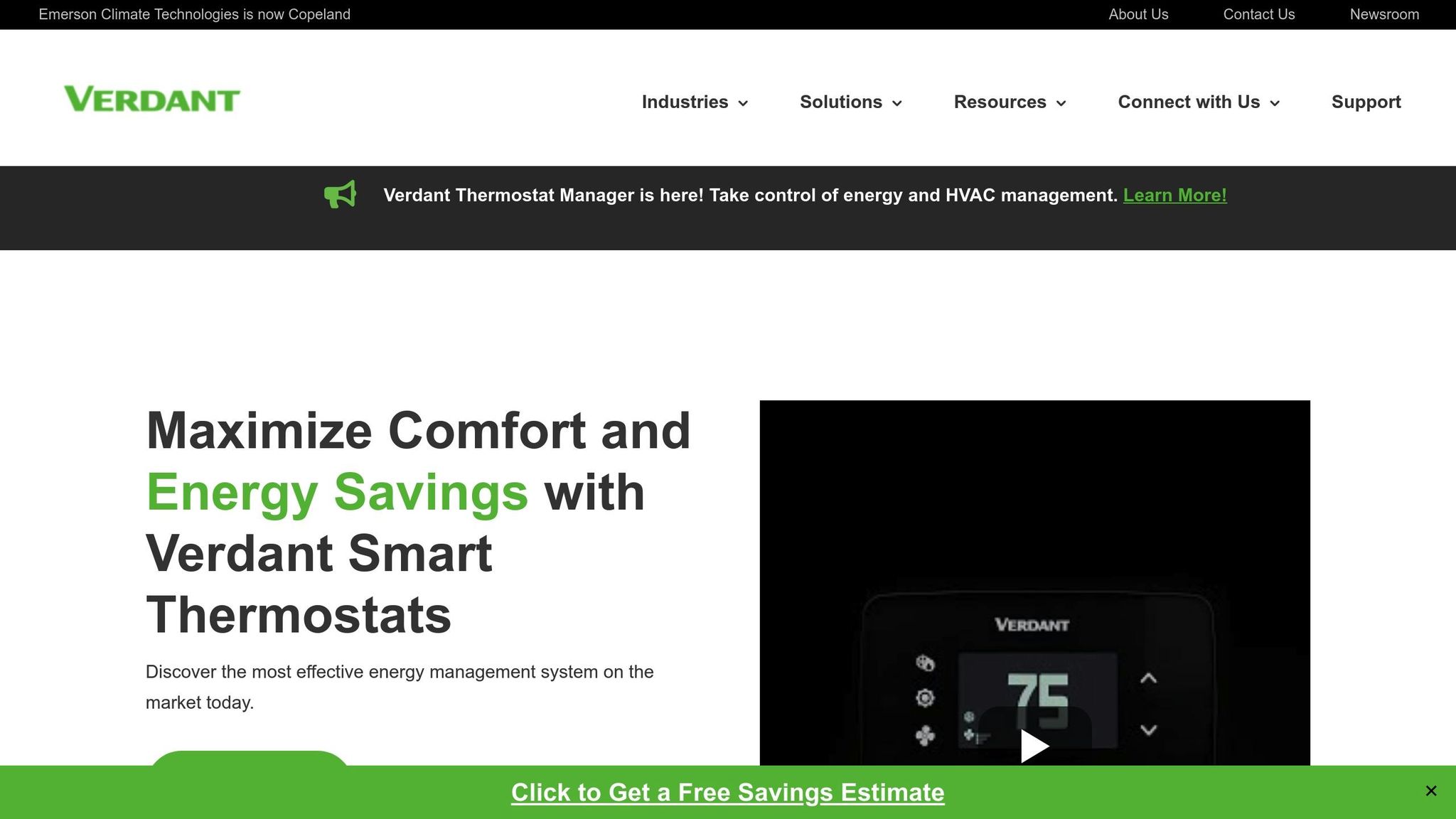Smart thermostats are transforming HVAC management in multifamily properties by cutting energy costs, improving tenant satisfaction, and simplifying operations. Here's what you need to know:
- Energy Savings: Reduce energy usage by 10-15% and cut utility bills by up to 26%.
- Remote Management: Control temperatures across multiple units from anywhere, saving time and boosting efficiency.
- Preventive Maintenance: Identify HVAC issues early, reducing repair costs by up to 25%.
- Tenant Demand: 82% of renters prefer smart devices, with 72% prioritizing smart thermostats.
- Financial Impact: Boost annual net operating income (NOI) by up to $135,000 through energy savings and operational efficiency.
Smart thermostats are no longer optional - they’re a practical tool for reducing costs and meeting renter expectations. Keep reading to explore top vendors, integration tips, and real-world success stories.
Smart Thermostat AND Smart HVAC #smarthometech #smartthermostat #carrier #smarthome
How Smart Thermostats Developed in Multifamily Buildings
The rise of smart thermostats in multifamily housing has been driven by a mix of economic pressures, growing resident expectations, and advancements in technology. These devices have become essential as the industry shifts toward a "home-as-a-service" model, which combines smart technology with tailored services to elevate the living experience. For property managers, smart thermostats provide a practical way to meet operational goals while catering to residents' increasing demands [10].
Main Reasons for Adoption
Rising operational costs - up by an average of 26% since 2022 - have prompted many property managers to adopt smart thermostats. These devices can cut utility expenses by 10–15%, potentially increasing annual net operating income (NOI) by as much as $135,000 [10][11].
Surveys highlight growing demand for smart technology among renters. For instance, a study by Schlage and Wakefield Research revealed that 86% of millennials are willing to pay nearly 20% more for apartments equipped with smart features. Similarly, the 2024 Renter Preferences Survey found that 72% of renters prioritize having smart thermostats in their homes [8][10].
Regulatory pressures and sustainability goals have also played a significant role. Many U.S. cities now offer incentives for energy-efficient housing, and smart thermostats help properties qualify for tax breaks, green certifications, and other benefits. Energy Star-rated systems, for example, can cut HVAC energy consumption by up to 23%, enabling properties to meet stricter environmental standards [11]. Tenant interest in energy-efficient housing has also surged, with a 20% increase reported in 2024, giving properties with smart HVAC systems a competitive edge [11].
These combined financial, regulatory, and tenant-driven factors are reshaping priorities in property management.
Changes in Property Management Priorities
As smart thermostats gain traction, property managers are shifting their operational strategies to embrace full-scale technology integration. Moving from manual controls to centralized, automated systems has streamlined multifamily operations in several key ways.
For one, centralized control allows property managers to reduce energy usage in vacant units by up to 20%, cutting unnecessary costs [6]. Predictive maintenance is another game-changer. Smart thermostats can identify when HVAC systems are under strain, allowing managers to address issues before they lead to expensive breakdowns. This approach can reduce maintenance costs by 18–25% and cut unplanned downtime by as much as 50% [11][12].
Integration with property management software has further simplified operations. Managers can now oversee multiple properties from a single dashboard, receive automated alerts about system issues, and generate detailed energy usage reports. This level of control makes it easier to manage larger portfolios without compromising service quality.
Data analytics provided by smart thermostats have become central to decision-making in property management. Detailed insights into energy usage and system performance help managers optimize maintenance schedules, plan energy procurement, and offer personalized services to residents. Balancing individual temperature preferences with centralized energy oversight is key to meeting modern expectations while keeping costs in check.
These advancements reflect an industry-wide shift toward more efficient, technology-driven operations. Smart thermostats are at the heart of this transformation, equipping property managers with the tools they need to navigate the complexities of modern multifamily housing management.
Main Benefits of Smart Thermostats for HVAC Management
Smart thermostats offer a range of benefits that go beyond simple temperature adjustments. They provide advanced HVAC management tools that improve property operations while enhancing resident comfort and satisfaction.
Energy Savings and Lower Costs
Smart thermostats are known to significantly reduce energy costs by using intelligent climate control. For example, devices like the Nest Learning Thermostat have been shown to lower heating and cooling expenses by 10–15% in multifamily properties [4]. In some cases, these systems can cut energy waste and utility bills by as much as 20% [4].
These savings come from several features working together. Programmable scheduling allows thermostats to automatically adjust temperatures based on daily routines. Geofencing technology detects when residents are away and adjusts settings accordingly [4]. Occupancy sensors further enhance efficiency by lowering temperatures in unused spaces [13]. Additionally, zone-based management ensures energy is only used where it's needed, avoiding unnecessary heating or cooling of vacant areas.
When paired with high-efficiency HVAC equipment, the potential savings grow even more. For instance, integrating smart thermostats with high-efficiency heat pumps can achieve up to 50% energy savings compared to older systems [9]. Similarly, Energy Star–certified smart systems can cut HVAC energy consumption by up to 23% [11]. Beyond cost reductions, these systems also improve operational efficiency, making them a smart choice for property managers.
Centralized Control and Remote Management
Smart thermostats also simplify HVAC operations through centralized control. Property managers can oversee and manage energy usage across multiple units from a single platform, eliminating the need for on-site adjustments.
"Smart thermostats allow operators to centrally control temperatures across multiple units, ensuring energy isn't wasted and that buildings operate efficiently." - Jason Korstad, National Account Manager for Multifamily, Property Technology, and Developers, Resideo [11]
Remote management features are especially valuable. For example, managers can adjust temperatures in vacant units to reduce energy costs while maintaining optimal conditions [11]. This capability has led to a 20% boost in operational efficiency for multifamily properties [2]. In larger communities, such as a 300-unit property, smart automations and centralized controls can save management teams an average of 1,300 hours annually while cutting energy usage by approximately 26% [7].
Integration with property management software further enhances efficiency. By combining resident information, maintenance requests, and automation settings into one dashboard, managers can streamline operations. Real-time monitoring also enables quick responses to system issues or resident concerns, reducing delays and improving service quality.
Preventive Maintenance and Equipment Protection
Smart thermostats play a key role in improving HVAC system reliability by enabling proactive maintenance. These devices monitor airflow and temperature patterns, identifying potential issues before they become costly repairs [16].
Features like automated alerts and sensor data help schedule timely tasks, such as filter replacements [14]. Some systems even provide real-time diagnostic reports and runtime analytics, making preventive maintenance more efficient [15]. This proactive approach not only protects expensive HVAC equipment but also ensures smoother operations.
"We spend thousands of dollars on equipment, and something as simple as not replacing the filter can cause a $7,000 unit to go bad in a short period of time. Doing preventive maintenance three months before the summer hits saves us tons of money and helps with energy consumption. It also keeps the residents happy because they don't have to call us with problems." - Avery Rouse, regional maintenance director at The Breeden Co. [17]
The data collected by smart thermostats allows property managers to optimize maintenance schedules based on actual system usage. This ensures resources are used effectively, equipment performance is maximized, and residents experience fewer disruptions.
sbb-itb-58157f8
Top Smart Thermostat Vendors for Multifamily Buildings
Smart thermostat vendors are stepping up to meet the specific needs of multifamily properties. Unlike standard residential models, these systems offer centralized management, bulk control options, and commercial-grade features that property managers depend on to streamline HVAC operations.
NetX (Network Thermostat)

NetX provides a robust solution for multifamily HVAC management through its CloudManager™ platform. This system allows property managers to oversee HVAC operations with centralized control and supports multiple user roles, including Admin, Contractors, Maintenance, and Residents. NetX also includes features like HVAC submetering for tenant billing and water leak detection sensors that alert staff to potential issues quickly. These capabilities not only enhance energy efficiency but also increase property value and help prevent costly damage. By upgrading to NetX smart thermostats, properties can reduce energy expenses and improve their overall competitiveness in the market [18].
Ecobee

Ecobee stands out as a cost-effective option for multifamily buildings, offering its SmartBuildings platform for just $2 per month per thermostat (billed annually). This cloud-based system enables remote management of multiple thermostats, making it easy to handle energy use across properties. Key features include user authorization, passcode protection, bulk scheduling, temperature alerts, and customizable team roles. Real-time monitoring and detailed usage reports further simplify energy management.
A notable success story comes from The Collier Companies, a student housing operator, which reported a 17% reduction in energy costs after implementing Ecobee SmartBuildings. Fellowship Square praised the platform as "the most affordable, user-friendly solution." Ecobee's thermostat models range from $129.99 to $249.99:
- Smart Thermostat Essential: Starting at $129.99.
- Enhanced Model: Priced at $189.99, offering up to 26% annual energy savings.
- Premium Model: At $249.99, it includes advanced features like an air quality monitor and smart speaker functionality [1][19][20].
Verdant

Verdant caters to larger, commercial-grade multifamily properties with specialized features designed for efficiency and durability. Its thermostats incorporate passive infrared motion sensors to detect occupancy patterns accurately, ensuring energy is only used when needed. The ZX smart thermostat was one of the first to include AAA batteries and an e-paper display, reducing power consumption and lowering maintenance costs. Additional features include night occupancy mode, dynamic recovery mode, advanced humidity control, flexible temperature setbacks, and detailed energy savings reports.
When considering Verdant, property managers should evaluate factors like pricing, design, system compatibility, and installation requirements to ensure the solution aligns with their needs [21][22].
Integration Methods and Best Practices
Integrating smart thermostats into multifamily properties isn't just about installing gadgets - it's about ensuring all components work together to maximize energy efficiency and operational savings. Here's a closer look at how to make that happen.
Making Sure Systems Work Together
Before jumping into installations, a compatibility check is a must. Property managers need to verify that the smart thermostats they choose align with their existing HVAC systems. This includes checking voltage requirements, wiring setups, and the specific type of heating and cooling equipment in use.
"Simple upgrades - replacing thermostats, updating packaged units, or switching systems - typically require minimal changes." - Rony Cherian, product manager and application engineer, Friedrich Air Conditioning [9]
The C-wire, or common wire, often becomes a key factor. Most smart thermostats need a continuous power supply, which the C-wire provides. If the HVAC system is older and lacks a C-wire, power extenders or adapters can solve the issue [25][26].
For more complex or outdated systems, consulting with HVAC technicians and using online compatibility tools from manufacturers can help identify and address potential issues [25]. To minimize disruptions, staggered installations across units are a smart approach. This allows property managers to troubleshoot any issues early without affecting all residents at once.
"Multifamily property managers can also schedule staggered installations across different units to minimize downtime. The benefits of reducing energy costs and increasing tenant comfort far outweigh the challenges of retrofitting." - David Rames, senior product manager, Midea [9]
Reliable Wi-Fi is another crucial piece of the puzzle. Smart thermostats rely on consistent connectivity to perform effectively [3].
Integrating these devices with property management software opens up even more possibilities. For example, automated scheduling can sync with unit occupancy patterns, lease schedules, and maintenance appointments. This streamlines operations and ensures that energy use is optimized during vacancy periods [23][24].
These strategies lay the groundwork for successful integration, as demonstrated by real-world examples.
Case Studies: Successful Implementations
Real-world examples show how smart thermostat integration can drive meaningful results. Take ADT's client, a regional operator managing multiple low-rise multifamily properties. After upgrading two communities with smart technology, the operator saw a 17% drop in energy costs and a 38% reduction in maintenance work orders. These improvements also boosted tenant satisfaction, increased lease renewals, and enhanced the property's net operating income (NOI) and long-term value [6].
Several smart practices contributed to this success:
- Manual adjustments for baseline schedules: The management team spent two weeks fine-tuning thermostat schedules to find the most efficient settings.
- Energy monitoring: By analyzing weekly and monthly energy reports from thermostat apps, property managers identified high-consumption periods and made targeted adjustments to cut costs.
- Complementary smart devices: Adding door and window sensors helped prevent energy waste by pausing HVAC systems when doors or windows were left open [24].
- Temperature setback programming: Adjusting temperatures by 7°F to 10°F for eight hours daily resulted in up to 10% annual savings on heating and cooling bills [27].
Zoning strategies also played a big role. Instead of applying a one-size-fits-all schedule, thermostats were tailored to each zone's unique needs. For instance, corner units, top-floor apartments, and spaces with varying sun exposure were programmed differently to optimize both comfort and efficiency.
Geofencing added yet another layer of savings. With tenant permission, thermostats linked to residents' smartphones could automatically switch to power-save mode when units were unoccupied and resume normal settings upon their return. This not only conserved energy but also maintained tenant comfort.
Across the board, properties implementing smart thermostat systems saw energy savings between 10% and 15%, with some common areas reporting reductions of 15% to 40% in HVAC energy use [5][13].
These examples prove that when approached methodically, smart thermostat integration delivers measurable benefits for property managers, tenants, and the bottom line.
Conclusion: Changing HVAC Management with Smart Thermostats
Smart thermostats are reshaping how multifamily properties manage HVAC systems, offering energy savings of 10–15% that are both measurable and impactful [4].
The growing demand for smart technology among tenants highlights its importance. With 82% of renters now favoring at least one smart device in their home - and tenant interest in energy-efficient properties expected to rise by 20% in 2024 - smart thermostats have become a must-have for property managers aiming to stay competitive [11]. These shifts point to a future filled with more technological advancements.
The U.S. smart thermostat market is on a rapid growth trajectory, expanding at an annual rate of 17.2% and expected to hit $3.86 billion by 2029 [4]. Emerging technologies like AI-powered climate control, real-time data via 5G, and the adoption of the Matter standard are set to further enhance system efficiency [28].
Upcoming innovations include features like multi-user recognition for personalized temperature settings, smart zoning to manage room-specific climates, integration with renewable energy sources, advanced air quality tracking, and automated ventilation systems [29][30].
Industry leaders are taking note of this evolution.
"For landlords, installing high-efficiency heat pumps and smart thermostats allows them to promote energy savings that can then be passed on to tenants or used as a value proposition to increase rental income...Additionally, connected smart thermostats offer tenants control over their energy usage, enhancing comfort while helping to reduce waste. This type of technology can differentiate a property in a competitive market, driving higher demand." – David Rames, Senior Product Manager, Midea [9]
To fully leverage these benefits, property managers should invest in dedicated Wi-Fi networks, choose Matter-compatible devices, and consider running pilot programs to ease the transition to smart technologies [4][28].
FAQs
How do smart thermostats help prevent HVAC issues and lower repair costs?
Smart thermostats are game-changers when it comes to keeping HVAC systems in top shape. By leveraging advanced sensors and analytics, they can spot potential issues early on. This means maintenance teams can step in and fix problems before they turn into costly breakdowns. The result? A noticeable reduction in repair costs - up to 30–40% in maintenance expenses - and a longer lifespan for HVAC equipment.
These devices also enhance efficiency by fine-tuning temperature control, which eases the workload on HVAC systems. Less strain means fewer repairs and a smoother operation overall. For property owners and managers, this translates to better system performance and considerable savings.
What should I consider before adding smart thermostats to a multifamily HVAC system?
When adding smart thermostats to a multifamily HVAC system, the first step is ensuring they work well with the current equipment and wiring. Opt for models that offer remote control and zoning capabilities, as these can boost energy efficiency while enhancing tenant comfort.
Getting the installation and calibration right is key to unlocking their full potential. Additionally, setting up remote monitoring and management can simplify overseeing multiple units - a big advantage for multifamily properties. Prioritize thermostats that strike a balance between user-friendly features, reliable performance, and long-term energy savings.
How do smart thermostats improve tenant comfort and help increase rental income in multifamily properties?
Smart thermostats take tenant comfort to the next level by automating temperature control, offering remote access via mobile apps, and syncing seamlessly with voice assistants like Alexa or Google Assistant. These features make daily life easier and allow tenants to enjoy a more tailored and convenient living environment.
But the benefits don't stop there. For property owners, smart thermostats can also boost rental income. By optimizing HVAC usage, they cut energy consumption and typically save about 10–15% on utility bills. This not only appeals to tenants who prioritize eco-friendly living but also helps increase occupancy and tenant retention. Plus, energy-efficient upgrades like these can support higher rental rates and add to the property’s overall value.


